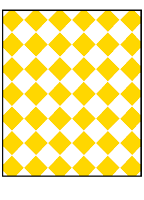Heraldry as practiced in courts and kingdoms of humankind features three basic types of tincture; metal, color, and fur. Of metals there are only two; argent (silver/white) and Or (gold/yellow). The basic rule (although there are exceptions known as “arms of enquiry”) is that metals should never be placed upon metals in a coat of arms, and colors never be placed upon colors, thus almost all human arms contain either white or yellow.
 |
| “Bronze” |
In dwarven heraldry, on the other hand, these rules and tinctures are quite different. Whereas human heraldry has only two metals, dwarven heraldry has platinum, electrum, silver, gold, copper, bronze, iron, and tin. “Bronze” in this case is a fine diamond-checkered pattern of copper and tin, whereas “electrum” is a similar pattern of silver and gold; they can thus be seen as analogous to the human furs, although dwarven heralds will vehemently resist such comparisons and strenuously defend their classification as metals. Metals are rendered in metallic paints (which are in some cases more expensive than the metals themselves) or in the actual metals.
 |
| “Electrum” |
Dwarven heraldry lacks colors, having gemstones instead; topaz, diamond, sapphire, ruby, amethyst, and emerald. These are, however, generally rendered as yellow, white, blue, red, purple, and green, respectively. Some spectacular renderings of dwarven heraldry will contain the actual gemstones, but these are almost invariably only used for decorative or ritual purposes.
 There are no general rules about mixing colors and metals, although there are rules about specific combinations of tinctures; topaz should never be placed atop gold (and vice versa), diamond and platinum should not be mixed, nor should platinum and silver.
There are no general rules about mixing colors and metals, although there are rules about specific combinations of tinctures; topaz should never be placed atop gold (and vice versa), diamond and platinum should not be mixed, nor should platinum and silver.
Ordinaries, divisions, creatures, and objects are generally the same in both human and dwarven heraldry, although the terms are, naturally, translated into dwarvish. Nautical creatures and objects (anchors, fish, etc.) are never seen on dwarven heraldry, but objects like anvils, hammers, axes, and mine carts abound.

Finally, the standard shape for dwarven arms is the round shield (as opposed to other types common in human heraldry such as the escutcheon or lozenge).
Humans often have difficulty distinguishing between some of the tinctures used in dwarven heraldry; platinum and silver, for example. Dwarven heralds scoff at such complaints, however, pointing out that dwarven heraldic devices were originally designed to appeal to refined dwarven sensibilities and not the eyes of a race that “can’t tell pyrite from gold.”
(Thanks to Inkwell Ideas’ excellent Coat of Arms Visual Designer, which was used to create most of the images above, with modifications to shield shape made in GIMP.)










Awesome stuff for us heraldry nerds … what represents black in the system?
Iron; it would be displayed as a sort of "gunmetal black".
I would assume that the closest analog would be the dark grey of iron. I'm just glad that the red-grey (sorry, ruby-silver) of the few Dwarves I have already painted will still work!
I'm pretty sure I'm about one of three heraldry nerds out there that might actually care about this stuff, but painting the dwarven figures brought it to the forefront of my mind.
Very Cool!!!